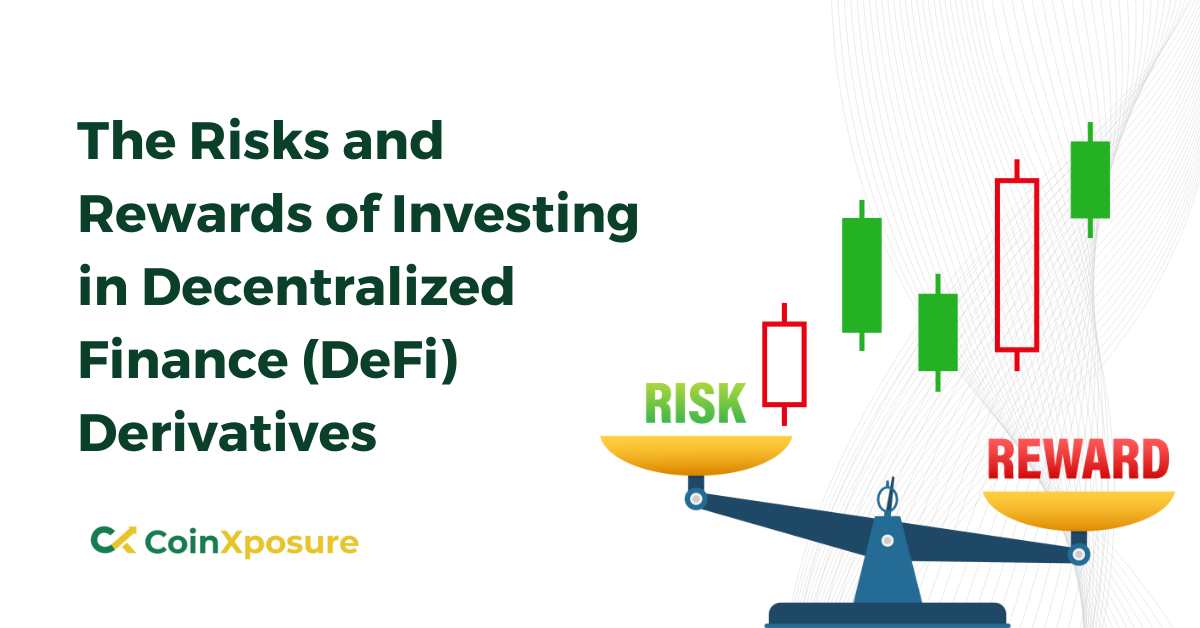
The Risks and Rewards of Investing in Decentralized Finance (DeFi) Derivatives
Decentralized Finance (DeFi) has revolutionized the traditional financial landscape by offering an open, permissionless, and borderless ecosystem for financial activities. Within DeFi, derivatives have emerged as powerful instruments that enable investors to speculate on, hedge against, or gain exposure to various assets.
This article explores the dynamic landscape of DeFi derivatives, shedding light on the associated risks and rewards. As DeFi continues to redefine how we interact with and invest in financial markets, it is essential to understand the potential gains and pitfalls when engaging with DeFi derivatives.
Understanding DeFi Derivatives
Decentralized Finance (DeFi) derivatives are financial contracts or instruments that derive their value from underlying assets, such as cryptocurrencies, stocks, commodities, or other assets. Still, they are built and traded on blockchain platforms rather than traditional financial institutions.
Here’s a breakdown of key concepts related to understanding DeFi derivatives:
Definition
DeFi derivatives are smart contracts that replicate the features of traditional financial derivatives, including options, futures, perpetual swaps, and synthetic assets. They enable users to gain exposure to the price movements of various assets without directly owning them.
Types of DeFi Derivatives
- Options: These contracts provide the holder with the right, but not the obligation, to buy (call) or sell (put) an underlying asset at a predetermined price (strike price) within a specified timeframe.
- Futures: Futures contracts obligate traders to buy or sell an asset at a predetermined price and date. These are used for speculation and hedging.
- Perpetual Swaps: These are similar to futures but without an expiry date. They allow endless trading of an asset’s price.
- Synthetic Assets: DeFi platforms create synthetic assets that mimic the value of real-world assets, such as stocks, commodities, or fiat currencies.
Key Features and Benefits
- Decentralization: DeFi derivatives are built on blockchain technology, ensuring transparency, immutability, and trustless execution.
- Liquidity: DeFi platforms often offer high liquidity due to the global user base and automated market-making protocols.
- Accessibility: DeFi derivatives are open to anyone with an internet connection and a compatible wallet, making them accessible to a global audience.
- Diversification: Traders can diversify their portfolios by gaining exposure to various assets without dealing with multiple intermediaries.
- Yield Farming: Some DeFi platforms allow users to earn yields by providing liquidity to derivative markets or staking tokens.
Understanding DeFi derivatives is crucial for investors and traders looking to leverage the opportunities within the DeFi ecosystem, but it’s equally important to be aware of the associated risks and develop effective risk management strategies.
The Rewards of Investing in DeFi Derivatives
Investing in Decentralized Finance (DeFi) derivatives offers several potential rewards for participants in the ecosystem. Here are some of the key benefits:
- Potential for High Returns
- Liquidity and Accessibility
- Decentralization and Trustless Nature
- Diversification Opportunities
- Yield Farming and Staking
Potential for High Returns
DeFi derivatives can provide substantial opportunities for profit due to their leverage. Traders can amplify their gains if they correctly predict price movements, leading to higher returns compared to traditional investments.
Liquidity and Accessibility
DeFi derivatives markets often exhibit high liquidity, allowing traders to enter and exit positions quickly. Additionally, these markets are accessible to anyone with an internet connection, enabling a more inclusive financial environment.
Decentralization and Trustless Nature
DeFi derivatives are built on blockchain technology, eliminating the need for intermediaries like banks or brokers. This decentralization fosters trust as transactions are executed through smart contracts, reducing the risk of fraud or manipulation.
Diversification Opportunities
DeFi derivatives enable investors to diversify their portfolios by gaining exposure to a wide range of cryptocurrencies, traditional stocks, commodities, and more. This diversification can help spread risk.
Yield Farming and Staking
Many DeFi platforms offer additional opportunities for income through yield farming and staking. Users can earn rewards by providing liquidity to derivative markets or locking their tokens in smart contracts.
However, it’s important to note that these rewards come with significant risks. The high potential for gains in DeFi derivatives is counterbalanced by equally high risks, including smart contract vulnerabilities, price volatility, regulatory uncertainties, and counterparty risks.
Therefore, investors should approach DeFi derivatives with a comprehensive understanding of the potential rewards and a strategy for managing the associated risks.
The Risks of Investing in DeFi Derivatives
Investing in Decentralized Finance (DeFi) derivatives presents a range of risks that investors should carefully consider. Some of the prominent risks include:
- Smart Contract Vulnerabilities
- Price Volatility and Impermanent Loss
- Regulatory Uncertainty
- Counterparty Risks
- Limited Investor Protection
- Complexity and Learning Curve
Smart Contract Vulnerabilities
DeFi derivatives are built on smart contracts, and any vulnerabilities or bugs in these contracts can lead to financial losses. Exploits and hacks have occurred in the past, causing substantial damageice Volatility, and Impermanent Loss.
DeFi derivatives often involve assets with high price volatility, such as cryptocurrencies. Traders can experience significant losses if prices move against their positions. Impermanent loss can also affect liquidity providers in decentralized exchanges.
Regulatory Uncertainty
The regulatory landscape for DeFi is evolving, and it’s unclear how different jurisdictions will treat DeFi derivatives. Regulatory changes can impact the legality and operation of DeFi platforms and derivatives trading.
Counterparty Risks
While DeFi aims to eliminate intermediaries, counterparty risks are still involved, especially in decentralized exchanges and lending protocols. Users may face risks related to defaulting counterparties or inadequate collateral.
Limited Investor Protection
Unlike traditional financial markets, DeFi does not offer the same level of investor protection. There is no recourse to regulatory bodies or insurance schemes in case of disputes, losses, or fraud.
Complexity and Learning Curve
DeFi derivatives can be complex, and newcomers may struggle to understand their work. This complexity can lead to unintentional mistakes and losses.
Potential investors should conduct thorough due diligence, practice risk management, diversify their portfolio, and stay informed about regulatory developments and best practices within the DeFi space to navigate these risks. It’s essential to approach DeFi derivatives cautiously and only invest funds one can afford to lose.
Risk Mitigation Strategies
Given the inherent risks in the space, risk mitigation strategies are essential when investing in Decentralized Finance (DeFi) derivatives. Here are some strategies to help investors manage and reduce those risks:
- Due Diligence
- Diversification
- Risk Management Tools
- Use of Insurance Protocols
- Stay Informed
- Limited Leverage
Due Diligence
Thoroughly research the DeFi projects and platforms you plan to engage with. This includes checking the team’s credentials, project audits, and community sentiment. Be cautious of projects lacking transparency and a track record.
Diversification
Don’t put all your assets into a single DeFi derivative or platform. Diversify your investments across different assets and projects to spread risk.
Risk Management Tools
Many DeFi platforms offer risk management tools like stop-loss orders or limit orders. These can help automate your risk management strategy.
Use of Insurance Protocols
Some DeFi projects offer insurance options, allowing users to protect their investments against smart contract vulnerabilities or hacks. Consider using these insurance protocols when available.
Stay Informed
Keep up with the latest developments in the DeFi space, especially concerning the platforms and assets you’re involved with. This helps you react to changes or issues promptly.
Limited Leverage
Be cautious with leverage in DeFi derivatives. High leverage amplifies gains but also losses. Use leverage conservatively and understand the risks involved.
Remember that there is no one-size-fits-all strategy, and risk tolerance varies from person to person. Evaluating your risk appetite, staying cautious, and continually adapting your risk mitigation strategies as the DeFi landscape evolves is crucial.
Conclusion
Investing in Decentralized Finance (DeFi) derivatives offers a tantalizing blend of potential rewards and inherent risks. DeFi derivatives have redefined traditional finance by providing open and accessible platforms for trading and speculation.
The rewards are apparent, including the potential for high returns, liquidity, decentralization, diversification, and opportunities for yield farming. These benefits have attracted many participants, from professional traders to everyday investors.
However, the DeFi landscape is not without its challenges and risks. Significant concerns include smart contract vulnerabilities, price volatility, regulatory uncertainties, counterparty risks, and the absence of traditional investor protections. While the rewards can be substantial, the potential losses are equally significant.
Ultimately, the DeFi derivatives space is dynamic, continuously evolving, and sometimes turbulent. It presents both opportunities and pitfalls. Investors are responsible for approaching it with caution, intelligence, and a long-term perspective.
The DeFi landscape will continue to shape the future of finance, and those who engage in it wisely and adapt to its evolving challenges will be best positioned to harness its potential for financial growth and innovation.





